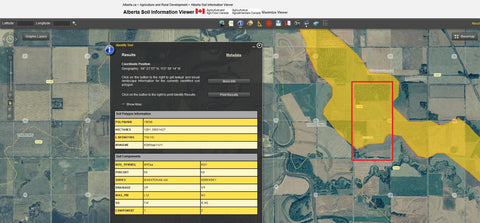Briana’s Introduction to Soil January 18, 2016 08:00
First big news for myself in 2016 is that my team, the Pandas Basketball Team kicked off this past weekend against Victoria Vikes, winning both games. We are currently ranked 8th nationally.
Classes began January 4th, and I am immensely excited for Principles of Animal Agriculture, Introduction to Management, and less excited for the mandatory Communications course and Applications of Linear Algebra.
This past semester I took introduction courses in plant science and soils which has enlightened me on a few things that apply back to our family farm. It relates to our day-to-day farm work and the choices our parents have made for managing our farm
Taking a soils class has been useful in my understanding of the many soils that cover Alberta and more widely, Canada. Using Alberta Agriculture and Forestry’s software, Agrasid, I looked more in depth into the soils that make up our farm. Mostly Organics with some areas Gleysols appear throughout our farm. There also some very small soil patches of the Chernozemic Order. I will explain these soils a little later on.
Knowing our soils allows us to be aware of the common water holding capacity, general pH levels, and the texture. These factors as well as many others, can affect what can be grown on our land, as well as what uses it has. The Canadian System of Soil Classification has 5 levels of soil identification, listed below from largest category to smallest;
Order Great Group Subgroup Family Series.
Soils are separated into one to three horizons. These horizons and the combination of the horizons lead to the categorization of soil types. There can be up to three horizons, labelled as ‘A’, ‘B’ and ‘C’.
Organics is a soil order that is made up of four Great Groups and Mesisol is one of these Great Groups. Almost 75% of our land is of the Mesisol Great Group, which most farmers refer to as peat, muskeg, or buckskin. An Organic Order is identified by the single horizon ‘A’ consisting of high organic matter (Agrasid identifies as ‘undifferentiated material’) consisting of various stages of decomposing plant matter. The Organics order can be in dry or wet areas. The mineral content is very low because there are no recent mineral deposits. By recent, I mean within the past 10,000 years. The soil is too new to have further developed into other soil types such as Chernozems, Solonetzs, Podzols or Luvisols which contains more minerals.
Growing crops on Organic soil is very difficult as you would face many challenges due to;
- Low water holding capacity - the soil has shrink/ swell abilities which leads to the formation of cracks
- High soil compaction - any time equipment drives through the field to seed, or spray or harvest crops, it causes large ruts
- Low soil density – with more air space, and less soil particles, a seed absorbs less moisture due to decreased contact area to soil. Less moisture can lead to a slower germination.

Screen shot of our home quarters soil type from Agrasid Information viewer
Gleysols are identified by the presence of gray or mottling appearance in horizon ‘B’ due to water causing soil reduction. Where Gleysolic soil is found on our farm, it is due to the sediments deposited by water over 10,000 years ago. In Alberta, the main soil types are Chernozems, Luvisols and Podzols, all very common for crop production. Gleysols are uncommon and the prevalence of it throughout our land has little impact on our decision making for the farm.
Chernozems are known to be great soils for growing crops because of their high mineral content and various other assets. It is highly fertile and often referred to as black soil. It is identifiable by its ‘A’ horizon containing organic matter, and its ‘B’ horizon can have high clay or carbon content. Although it is very common throughout Alberta’s grassland regions, it is rare on our farm which prevents us from utilizing its fertility.
Our passion for animal agriculture led to our decision to raise livestock on our land. Our choice to raise cattle, chickens, and turkeys on this land contributes to a higher productivity in comparison to growing crops.
To find out more about soil types on your farm, or your parents, or your friends farm, go to